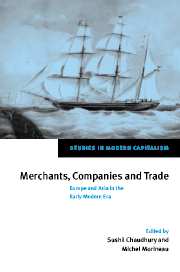Book contents
- Frontmatter
- Contents
- List of contributors
- Preface
- Introduction
- Part I Asia, especially India, around 1500
- Part II Routes, markets and merchants
- Part III European presence in Asia
- 8 The Portuguese and the Dutch in Asian maritime trade: a comparative analysis
- 9 Competition or collaboration? Relations between the Dutch East India Company and Indian merchants around 1680
- 10 The French India Company and its trade in the eighteenth century
- 11 Sweden and India in the eighteenth century: Sweden's difficulty in gaining access to a crowded market
- 12 The ambitions of the Austrian Empire with reference to East India during the last quarter of the eighteenth century
- Part IV Implications of trade: Asia and Europe
- Index
9 - Competition or collaboration? Relations between the Dutch East India Company and Indian merchants around 1680
Published online by Cambridge University Press: 02 December 2009
- Frontmatter
- Contents
- List of contributors
- Preface
- Introduction
- Part I Asia, especially India, around 1500
- Part II Routes, markets and merchants
- Part III European presence in Asia
- 8 The Portuguese and the Dutch in Asian maritime trade: a comparative analysis
- 9 Competition or collaboration? Relations between the Dutch East India Company and Indian merchants around 1680
- 10 The French India Company and its trade in the eighteenth century
- 11 Sweden and India in the eighteenth century: Sweden's difficulty in gaining access to a crowded market
- 12 The ambitions of the Austrian Empire with reference to East India during the last quarter of the eighteenth century
- Part IV Implications of trade: Asia and Europe
- Index
Summary
The Dutch East India Company, the Verenigde Oostindische Compagnie (VOC), differed from its European competitors because it succeeded in creating an extensive network of trade in Asia. The intra-Asian trade of the VOC yielded from circa 1640 substantial profits and provided the Dutch Company with silver and gold for the Indian and Indonesian markets. This network can be described very schematically as a ‘fan’ with Batavia as the ‘grip’: from this place a number of vertical lines can be traced to the north-west, the north and the north-east, to Persia, India and Ceylon, to Malacca, ‘further-India’, China and Japan. There was also a horizontal line, from the west to the east, from Persia and India to Malacca and Japan. Apart from these lines to the Asian continent and to Japan, the Company traded within the Indonesian archipelago.
The line with China in this network was weak. After the loss of Formosa in 1664, the Company failed to establish a regular trade with China and finally, in 1690, it left this trade to Chinese junks which visited Batavia in yearly growing numbers. The route from Batavia to Manila was a missing link. The peace treaty of 1648 between Spain and the Netherlands stipulated that the Spaniards in Asia should not extend their existing trade, while the Dutch were not allowed to visit Spanish harbours. The VOC made, in the seventeenth century, some half-hearted attempts to open the trade with Manila, but eventually the Dutch Company had to accept that it had to rely on intermediaries for the shipping between Batavia and the Philippines.
- Type
- Chapter
- Information
- Merchants, Companies and TradeEurope and Asia in the Early Modern Era, pp. 189 - 201Publisher: Cambridge University PressPrint publication year: 1999
- 2
- Cited by



